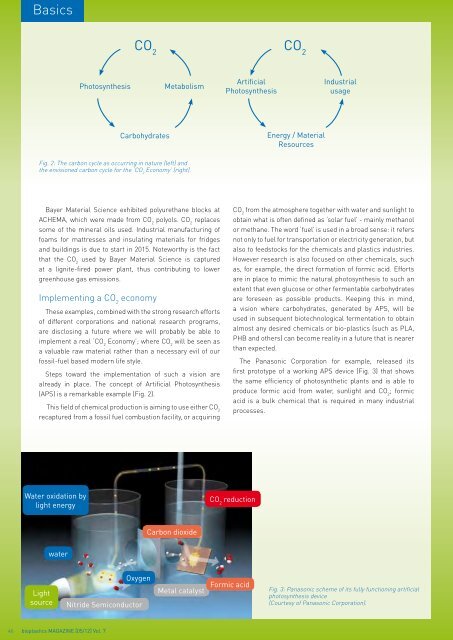bioplasticsMAGAZINE_1205
bioplasticsMAGAZINE_1205
bioplasticsMAGAZINE_1205
You also want an ePaper? Increase the reach of your titles
YUMPU automatically turns print PDFs into web optimized ePapers that Google loves.
Basics<br />
CO 2<br />
CO 2<br />
Photosynthesis<br />
Metabolism<br />
Artificial<br />
Photosynthesis<br />
Industrial<br />
usage<br />
Carbohydrates<br />
Energy / Material<br />
Resources<br />
Fig. 2: The carbon cycle as occurring in nature (left) and<br />
the envisioned carbon cycle for the ‘CO 2<br />
Economy’ (right).<br />
Bayer Material Science exhibited polyurethane blocks at<br />
ACHEMA, which were made from CO 2<br />
polyols. CO 2<br />
replaces<br />
some of the mineral oils used. Industrial manufacturing of<br />
foams for mattresses and insulating materials for fridges<br />
and buildings is due to start in 2015. Noteworthy is the fact<br />
that the CO 2<br />
used by Bayer Material Science is captured<br />
at a lignite-fired power plant, thus contributing to lower<br />
greenhouse gas emissions.<br />
Implementing a CO 2<br />
economy<br />
These examples, combined with the strong research efforts<br />
of different corporations and national research programs,<br />
are disclosing a future where we will probably be able to<br />
implement a real ‘CO 2<br />
Economy’; where CO 2<br />
will be seen as<br />
a valuable raw material rather than a necessary evil of our<br />
fossil-fuel based modern life style.<br />
Steps toward the implementation of such a vision are<br />
already in place. The concept of Artificial Photosynthesis<br />
(APS) is a remarkable example (Fig. 2).<br />
This field of chemical production is aiming to use either CO 2<br />
recaptured from a fossil fuel combustion facility, or acquiring<br />
CO 2<br />
from the atmosphere together with water and sunlight to<br />
obtain what is often defined as ‘solar fuel’ - mainly methanol<br />
or methane. The word ‘fuel’ is used in a broad sense: it refers<br />
not only to fuel for transportation or electricity generation, but<br />
also to feedstocks for the chemicals and plastics industries.<br />
However research is also focused on other chemicals, such<br />
as, for example, the direct formation of formic acid. Efforts<br />
are in place to mimic the natural photosynthesis to such an<br />
extent that even glucose or other fermentable carbohydrates<br />
are foreseen as possible products. Keeping this in mind,<br />
a vision where carbohydrates, generated by APS, will be<br />
used in subsequent biotechnological fermentation to obtain<br />
almost any desired chemicals or bio-plastics (such as PLA,<br />
PHB and others) can become reality in a future that is nearer<br />
than expected.<br />
The Panasonic Corporation for example, released its<br />
first prototype of a working APS device (Fig. 3) that shows<br />
the same efficiency of photosynthetic plants and is able to<br />
produce formic acid from water, sunlight and CO 2<br />
; formic<br />
acid is a bulk chemical that is required in many industrial<br />
processes.<br />
Water oxidation by<br />
light energy<br />
CO 2<br />
reduction<br />
Carbon dioxide<br />
water<br />
Light<br />
source<br />
Oxygen<br />
Nitride Semiconductor<br />
Metal catalyst<br />
Formic acid<br />
Fig. 3: Panasonic scheme of its fully functioning artificial<br />
photosynthesis device<br />
(Courtesy of Panasonic Corporation).<br />
46 bioplastics MAGAZINE [05/12] Vol. 7


















